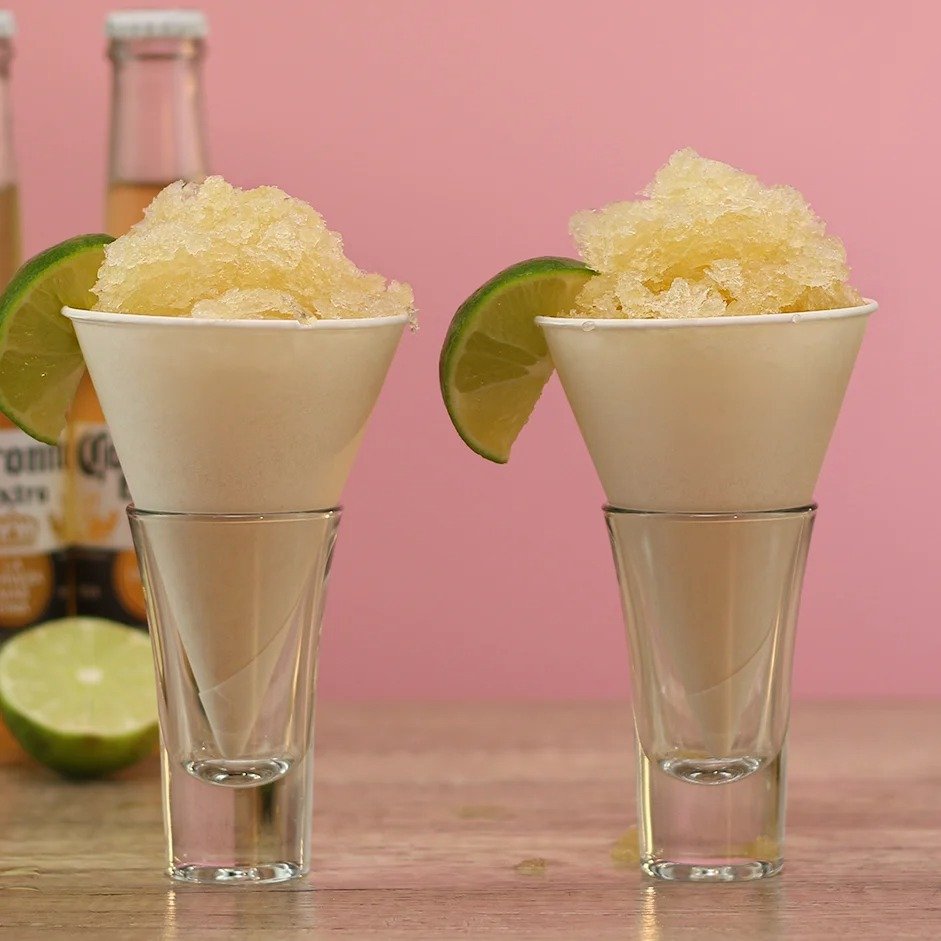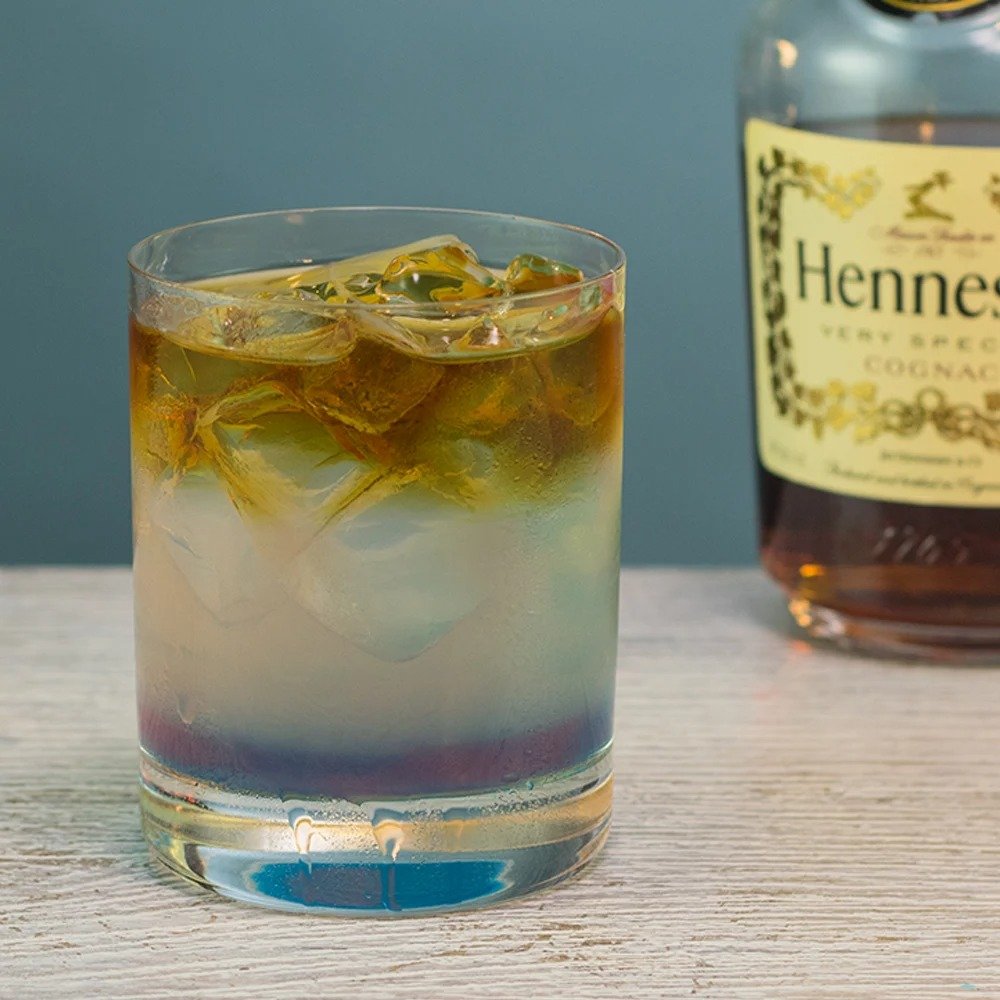
The Ultimate Rum Guide: Everything You Need to Know!
WELCOME TO RUM
OK, aspiring bartenders and home drink-slingers, it's time to learn all about everybody's favorite sugarcane-derived booze: rum! Yes, we're about to get tropical on ya'll (mol)asses with this sweet spirit, which is loved by pirates, Caribbean island vacationers, and just about everybody else who has a Tiki drink addiction. Although we shouldn't be quick to stereotype rum drinkers, 'cause this delicious spirit isn't only freakin' fantastic in piña coladas, daiquiris, mojitos, and mai tais, it's also more than decent as a solo sipper, much like a fine whiskey. https://giphy.com/embed/xUPJPIrxJ9snxysDHq But like any other spirit, you can't just go into the world of rum drink-making blind; you need to get all your facts straight, especially since you'll be expected to know all about rum's origins, its production process, and its categories now that you're on your way to becoming an expert bartender. So take a few minutes, sit down with a nice glass of Rhum Agricole (you'll learn what that is) and prepare for some serious learning. In this Ultimate Rum Guide we'll be covering everything from the history of rum to how rum's made to the different categories of rum to how to drink rum like a true aficionado — or Captain Jack Sparrow, if you've had a long week. https://giphy.com/embed/zuYV4h8GNfXhuWHAT IS RUM?
First things first: You already know that rum is a staple spirit of any bar — home or professional — but what exactly is it? The short answer, provided by the ever-useful Wikipedia: "Rum is a distilled alcoholic beverage made from sugarcane byproducts such as molasses... by a process of fermentation and distillation. [That resultant] distillate, a clear liquid, is then usually aged in oak barrels." What does that mean? Basically, it means that in order to make rum, what you'll need to do is plant a bunch of sugarcane — a species of tall grass — then chop it all down, crush it, extract the sugars from the crushed pulp (this is called sugarcane juice), then take that sugarcane juice — or molasses, which is a byproduct of the sugarcane sugar refining process — ferment it using yeast in order to produce an alcoholic liquid, and then distill that liquid in order to up its alcohol by volume (ABV) from something on the order of 10% ABV to 40% or even 84%. Obviously there are way more nuances and steps involved in the rum production process, but we'll get into all of that below. https://giphy.com/embed/3oEduGiVW0XI53Idl6 In terms of a brief origin of rum — you know, what you'll need to spit out if some smart-ass wants to test your rum cred — you'll want to know that most people trace its official establishment to when Christopher Columbus planted sugarcane in the Dominican Republic during his famous (infamous?) voyage to the New World in 1492. As far as the actual discovery that that sugarcane could be turned into an alcoholic spirit, that happened later, in the 17th century, when plantation slaves in the Caribbean discovered that molasses, the aforementioned byproduct of the sugar refining process, could be fermented into alcohol.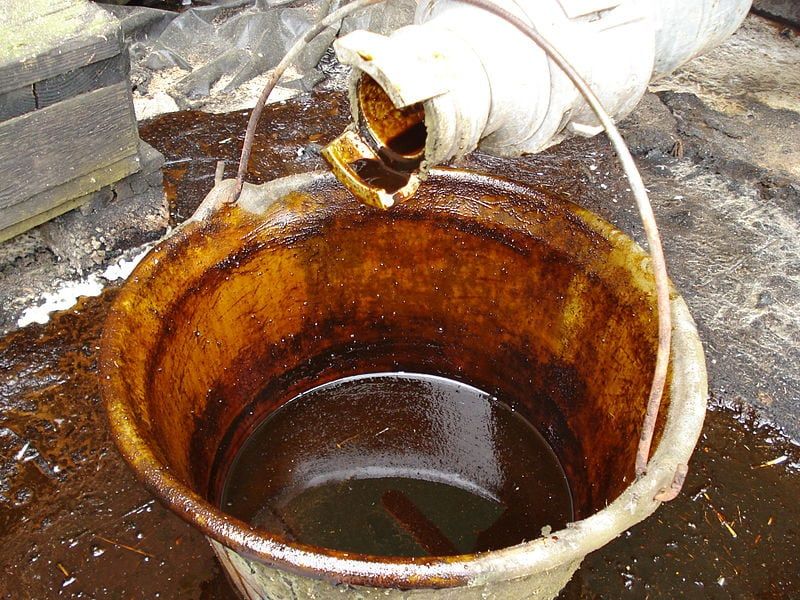
Yeah, this is molasses... Image: Wikimedia / Tractorboy60
And as long as we're talking about rum's origins, its etymology most likely comes from a shortened version of the word rumbullion (or rumbustion), an English word that surfaced in the English language around the same time that rum became the name for... rum. In regards to the definition for rumbillion, it was a slang term for "tumult" or "uproar." Which sounds like a good origin word for rum, right? As far as where the rum market's at today, things are looking brighter than a white sand beach in Puerto Rico. Rum sales hit an all-time high of nearly $3 billion in the U.S. alone in 2018, and they show no sign of stopping. And while rum is still mainly produced in the Caribbean and Latin America, it's also made in other countries around the world, including Austria, Canada, Fiji, the U.K., the U.S., the Philippines, South Africa, and tons of other locations. https://giphy.com/embed/LOyuRQkIXUEsE So to sum up the basics of what rum is: It's a distilled alcoholic spirit made from fermented sugarcane juice or molasses (usually molasses as that accounts for about 97% of the rum made in the world today), which originated in the late 17th century in the Caribbean, when plantation slaves accidentally discovered that molasses could be fermented into an alcoholic beverage. Now let's get into the history of rum!A BRIEF RUM HISTORY
Now that you all know what rum is, let's take a quick dive into its history. But this is going to be a relatively shallow dive. Books could be written on the history of rum — and they most definitely have — but for all intents and purposes as a bartender, you'll only need to know the broad strokes to feel like you can hold your own if a patron or (snarky) friend tries to throw a trivia challenge your way. Now without further ado, here's a super-brief overview of the journey rum has gone through in order to go from obscure grass plant found in Asia to delicious ingredient in that daiquiri that you love sipping on by the pool. BUT FIRST, LET'S TALK ABOUT SUGARCANE Without sugarcane, there would be no rum, so let's pay our respects and briefly talk about the history of this fine grass plant. Sugarcane, or Saccharum officinarum, is indigenous to tropical parts of Southeast Asia, although different species likely originated in different parts of the world, with Saccharum barberi coming from India and Saccharum officinarum coming from New Guinea. According to Wikipedia, the domestication of sugarcane and extraction of its sugarcane juice probably first took place in tropical Southeast Asia around 8,000 B.C.
A man chops down sugarcane grasses. Image: Wikimedia / Rmanyiza
Then, around 8,800 years later (9th century AD), Muslim and Arab traders took the sugarcane from Southeast Asia and spread it out to the Mediterranean, Mesopotamia, Egypt, North Africa, and Andalusia. By the 10th century AD, sugarcane was being grown across Mesopotamia — what's basically modern day Iraq and parts of the countries surrounding it. It was also one of the first crops brought over to the Americas by the Spaniards from their fields in the Canary Islands off the coast of Western Sahara and Morocco, as well as by the Portuguese from their fields in the Madeira Islands. CHRISTOPHER COLUMBUS AND THE DOMINICAN REPUBLIC Now that we have the basic history of sugarcane down, let's get to the good stuff (read: the more relevant stuff) and talk about Christopher Columbus bringing sugarcane to the New World. In 1492 — you know, when Columbus sailed the ocean blue and all that — he brought sugarcane over to the Caribbean and planted fields of the stuff, noting that this newfound tropical environment was perfect for it. But Columbus wasn't able to keep the sugarcane all to himself. According to Live Science, "Spanish colonizers snipped seeds from Columbus' fields in the Dominican Republic and planted them throughout their burgeoning Caribbean colonies. By the mid 16th-century the Portuguese had brought some to Brazil and, soon after, the sweet cane made its way to British, Dutch and French colonies such as Barbados and Haiti." But harvesting all of that sugarcane for its sugar was hard work. Hard work that was going to be done by slaves.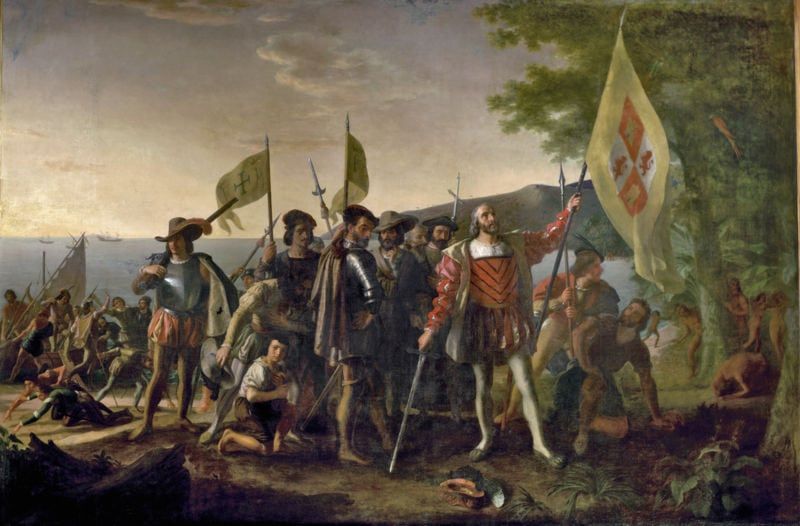
18th Century Painting of Columbus landing in the West Indies. Image: Wikimedia / Architect of the Capitol
THE TRADE TRIANGLE Now we need to dive into what was known as the Trade Triangle briefly because it involved slaves and slaves were a critical component of the discovery of rum. Basically, the Trade Triangle was a system of trading set up between European settlements in the Caribbean and the continents of Europe and Africa. The system worked by using slave labor in the Caribbean colonies to harvest sugar from the sugarcane fields, shipping that sugar to Europe where it could be traded for money and goods, and then using that money and those goods to buy more slaves from Africa, who would be shipped over to the Caribbean where they'd be used as plantation labor. Aside from being a horrible crime against humanity, this Trade Triangle inadvertently resulted in the discovery of rum, as it was slaves who realized that one of the byproducts of rum, molasses, could be fermented and turned into a low ABV alcohol.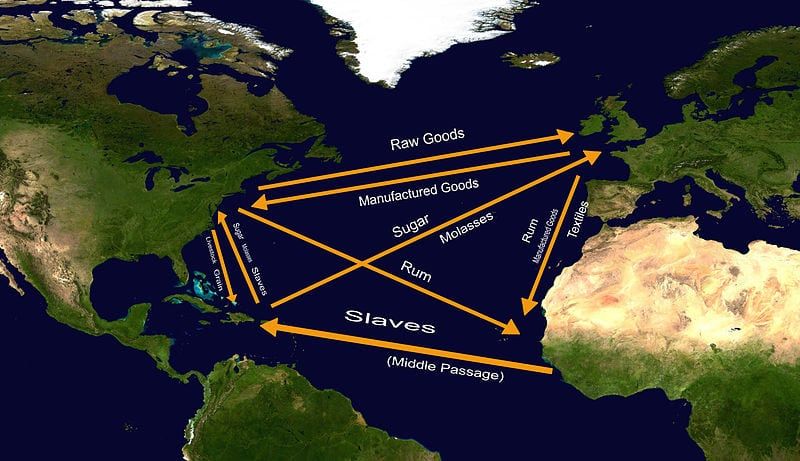
Diagram of the Trade Triangle. Image: Wikimedia / Supportstorm
As Food Editorial notes, "The first distillation of rum took place on the sugarcane plantations of the Caribbean in the 17th century. Plantation slaves first discovered that molasses, a by-product of the sugar refining process, fermented into alcohol. Later, distillation of these alcoholic by-products concentrated the alcohol and removed impurities, producing the first true rums." Sometime after it was discovered that molasses could be fermented into booze, it was then distilled, and that's how true, high ABV rum was first made. (By the way, at this point rum was going by several names, including "Kill Devil"....) So to sum up: The base alcohol used for rum was discovered in the 17th century when plantation slaves in the Caribbean noted that molasses could be fermented (have its sugars turned into alcohol by yeast). Sometime later it was distilled, and bang, you had modern-day rum. RUM'S HISTORY IN THE U.S. Once rum had been discovered and developed in the Caribbean, it eventually made its way over to the colonies in North America. There, the first rum distillery was set up in 1664 on Staten Island, which was followed by another distillery in Boston, MA three years later. Soon after that, rum became Colonial New England's largest, most profitable industry. The rum made in Rhode Island was so popular and coveted, in fact, that it even joined gold as an acceptable form of currency in Europe. (Rum was also traded between the colonists and the Native Americans, so really, everybody was loving pretty hard on rum.) Rum continued to become more and more popular in the colonies even after the American Revolution — George Washington even deminsisted on a barrel of Barbados rum at his 1789 presidential inauguration. Wikipedia also notes that "Rum [also] started to play an important role in the political system; candidates attempted to influence the outcome of an election through their generosity with rum. The people would attend the hustings to see which candidate appeared more generous. The candidate was expected to drink with the people to show he was independent and truly a republican."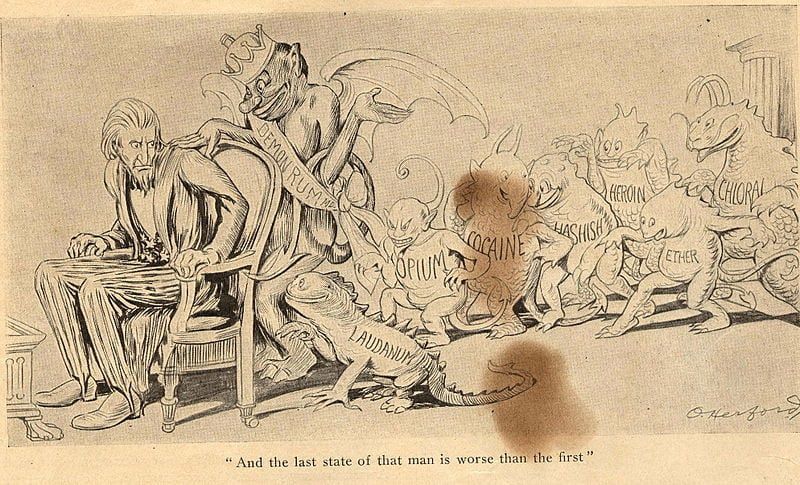
20th century depiction of Uncle Sam (U.S. government) being haunted and taunted by "Demon Rum" as well as other mind-altering substances. Image: Wikimedia / Oliver Herford
But rum's spot in the limelight didn'tdon last forever. Eventually, restrictions on sugar imports from the Caribbean islands settled by the British, as well as the rise of American whiskey, led to a steep decline in the popularity of rum in North America. There would eventually be a resurgence in the popularity of rum, however, and it came thanks to the rise of "Tiki culture" in the 1930s. If you're unfamiliar with it, Tiki culture — which was influenced by Tiki carvings and mythology, as well as Polynesian fine art — began in the U.S. with the opening of Don the Beachcomber, a Polynesian-themed bar and restaurant in Hollywood. The founder, Ernest Raymond Beaumont-Gantt, a Texan, had sailed through the South Pacific and decided to bring back to the states elements of the cultures he'd experienced.
Menu from Don The Beachcomber restaurant. Image: Wikimedia / California Historical Society Digital Collection
Part of Beaumont-Gantt's Polynesian cultural crossover included tropical rum drinks — y'know, like those served in Tiki glasses — and bang, rum was back. As Wikipedia notes, "Donn Beach [Beaumont-Gantt's newly adopted name, what a pimp...], the founder of Don The Beachcomber, is also credited as having created the tropical drink genre singlehandedly." On top of that, "Beach was the first restaurateur to mix flavored syrups and fresh fruit juices with rum." Beach called these drinks "Rhum Rhapsodies" and they made his restaurant in Hollywood a hotspot for the elite classes from the 1940s to the 1960s. His Tiki trend, as well as its component rum drinks, were copied by tons of other restaurant owners, which helped to amplify the popularity of rum in America. (As a side note, Beach is credited with creating iconic rum cocktails including the Zombie and the Scorpion.)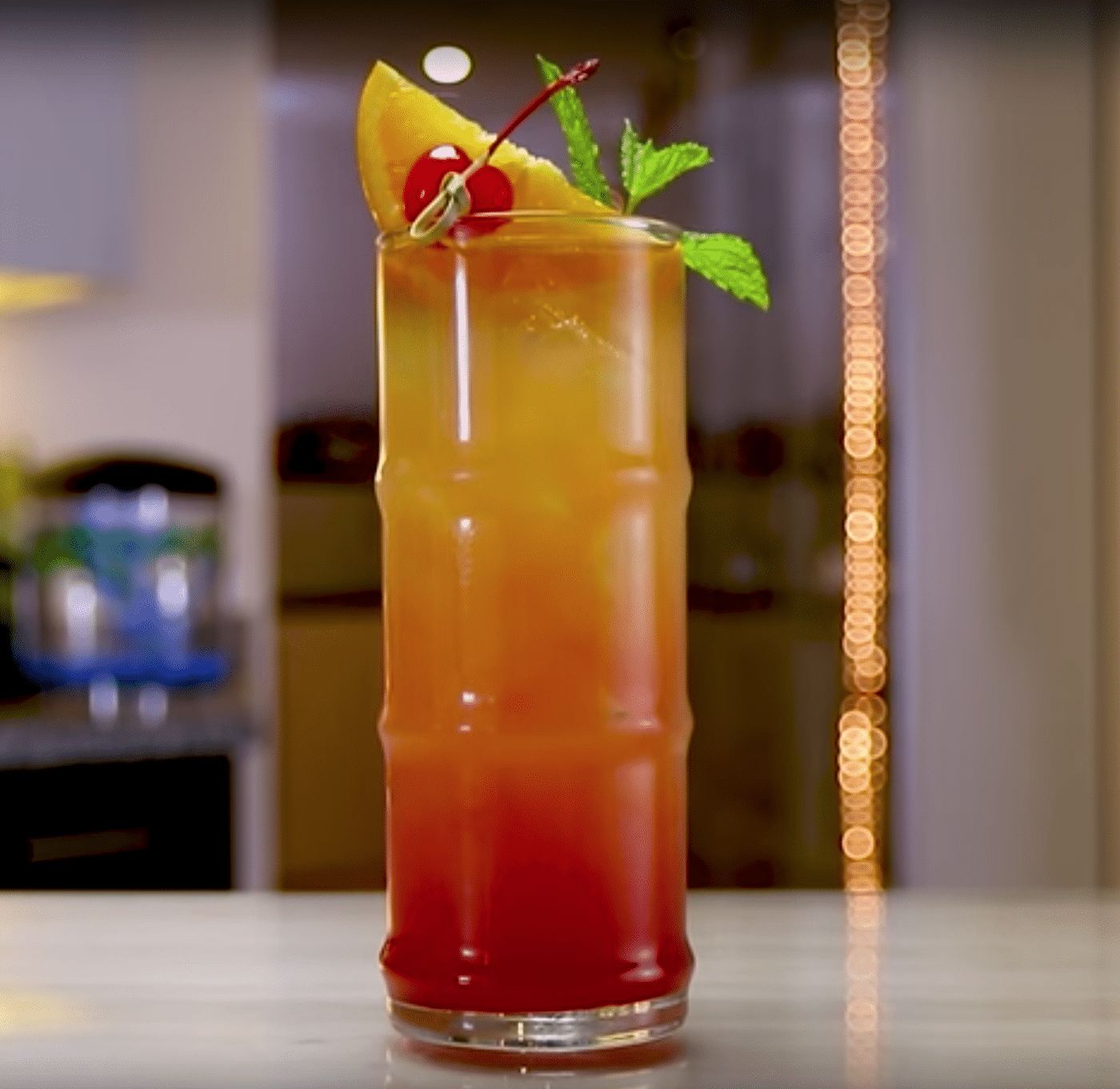
The zombie cocktail. Image: Tipsy Bartender
RUM IN TODAY'S WORLD
17th century portrait of Welsh buccaneer Henry Morgan — the man after which the Captain Morgan brand of rum is named. Image: Wikimedia / Alexandre Exquemelin
So rum became the go-to drink for British sailors, which was fine at first because booze is booze, y'know? But then the British Royal Navy committed one of the biggest crimes imaginable when it comes to alcohol: They started watering down the crap out of the rum in order to not only make the rations last longer, but also to prevent the sailors from getting too trashed all the time. This incredibly watered-down rum became known as "grog." (Lime or other citrus liquid was also sometimes added to grog.) But the sailors were going to have none of that watered-down bulls*!t. So many of them defected and either became private sailors under contract by the government (imagine an old school version of Blackwater mercenaries), or just straight-up pirates. But even after leaving the British Royal Navy to become contract sailors or pirates, they kept using rum as one of their staple drinking rations — it was also used to disinfect fresh water on the ships, which would become unhealthy after being stored aboard ships for extended periods of time. And while pirates were more than happy to drink just about any booze they could get their hands on — i.e. anything they could steal from merchant ships — they usually ended up sippin' on rum and water because that's what was being moved throughout the Caribbean.
18th century depiction of pirates carrying rum onshore to purchase slaves. Image: Wikimedia
There is, of course, a lot more to the story of pirates and rum, but for the broad strokes, that's basically the deal. So there was nothing epic or mythical about the connection between pirates and rum; it was just a matter of convenience and coincidence. But damn if being a 17th century pirate doesn't sound like a lot of fun, right?!HOW RUM IS MADE
OK, so let's say you've decided to make some rum from absolute scratch, what will you need to do in order to make that happen? You'll need to go through the following steps, which will take you from growing the sugarcane grasses to bottling the rum. Just a heads-up though, if you really are looking to make your own rum, it's going to be a very difficult process. Everything from chopping down sugarcane with a machete to barrel aging the rum takes a lot of time and effort, which is why we should be so appreciative of everybody who makes rum. Seriously, try cheering to some people in the Caribbean islands right before you take your next shot of rum with your friends; after you check out the following process you'll realize rum makers deserve it. https://giphy.com/embed/cekOrl88PlBIzQfbvn PLANTING AND HARVESTING SUGARCANE First thing you'll need to do to make rum is plant and harvest sugarcane. As was mentioned before, sugarcane is, according to Wikipedia, a group of "several species of tall perennial true grasses of the genus Saccharum... native to the warm temperate to tropical regions of South and Southeast Asia, Polynesia and Melanesia... [that is used] for sugar production." Although it's not super relevant to knowing how to make rum, you may want to know that sugarcane grows best in a tropical or temperate climate — hence its proliferation in the Caribbean, Southeast Asia, and South America — and grows best "in areas with a plentiful supply of water for a continuous period of more than six to seven months each year, either from natural rainfall or through irrigation."
A field of sugarcane. Image: Wikimedia / Petra Bensted
What's most often extracted from sugarcane, and what's made sugarcane an absolute staple of the modern diet and worldwide economic system, is, of course, its sucrose; a.k.a. sugar. But while you can definitely make rum from fermented sugarcane juice recall that the vast majority of the world's rum is actually made from molasses, which is a byproduct of that sugar extraction process. So for this first step, as it pertains to making rum, what you'll need to do is chop down a bunch of sugarcane stalks — utilizing either men swinging machetes or mechanical harvesting machines — and then bring them on over to a mill, where you'll move on to step two.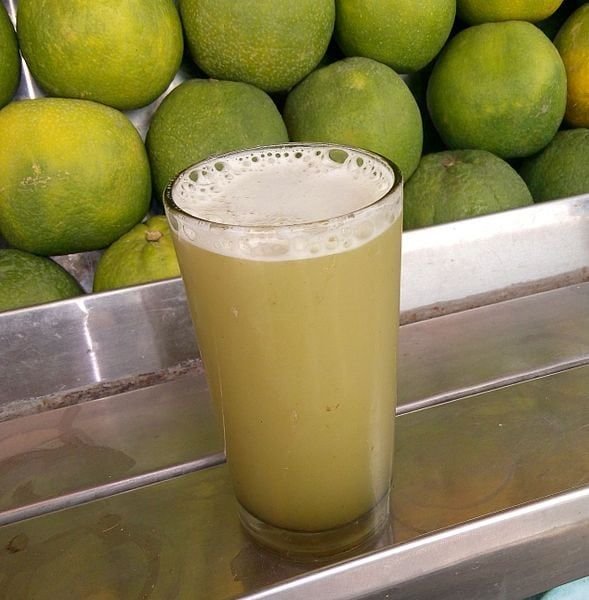
This is what fresh sugarcane juice looks like. Image: Wikimedia / Rupika08

Rum fermentation tanks (not especially fancy ones...). Image: Wikimedia / Stefan Ivanovich
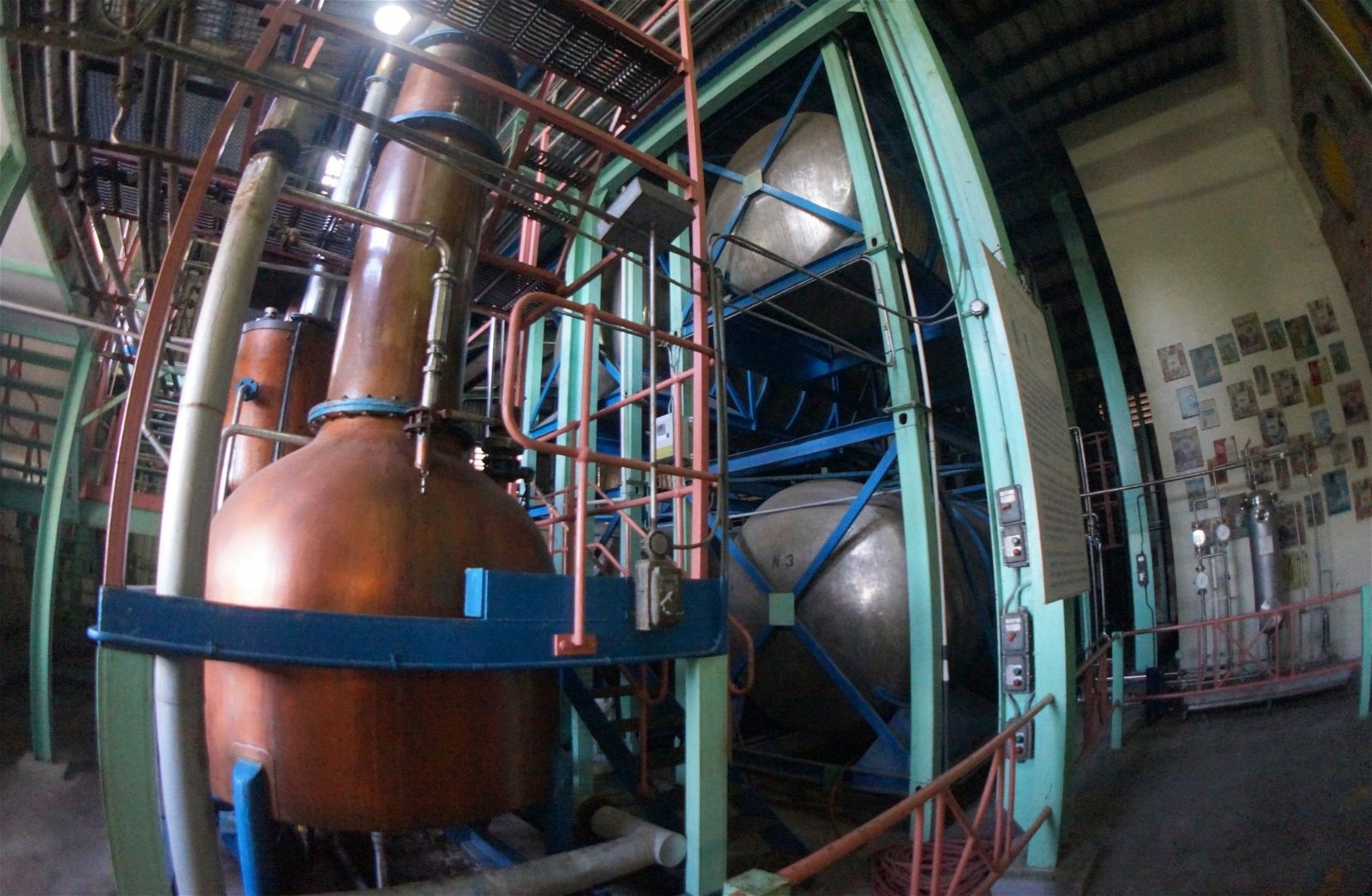
Pot stills used to distill rum. Image: Flickr / anax44
Basically, these stills are going to affect the flavor of the rum by removing certain flavor compounds (those aldehydes, esters, and acids mentioned earlier). Depending on the distillery, the rum going through the stills will also change flavor as it's combined with dunder — the liquid left in a boiler after distilling a batch of rum — or left for a longer period of time in column stills, which produces a lighter, cleaner rum. Now, there's a ton of other aspects to consider when talking about rum distillation (such as which parts of the rum vapors distillers will use; e.g. the first part of the ethanol vapors, the middle part, or the end part), but what's been described are the broad strokes. If you want to go really deep into rum distillation details, this Difford's Guide does a great job of covering all the different ways rum can be distilled. Although as a general rule of thumb, just know that distillation of rum varies immensely, and it's all dependent on the distillery's particular methods. BARREL AGING, CHARCOAL FILTRATION, AND RUM BLENDING Now that you have some distilled rum — which has an ABV of anywhere from 40% to 95% — you're ready to either bottle and sell it, barrel age it, blend it, and/or charcoal filter it. So let's take a quick look at our options: Barrel aging: When it comes to barrel aging rum, what you're basically looking at is using some type of oak barrel. According to Difford's Guide, the most common barrels used are American oak casks that are used fresh or have been previously been used to age bourbon (American whiskey). These oak casks are always charred, and are generally more flavorful than other barrel types because of said charring. In regards to how the rum actually absorbs flavors from the barrel in which it's aged, that comes down to the tannins, vanillins, and other flavor compounds present in the barrels' wood. The charring of the inside of the barrels also caramelizes the natural sugars on the surface of the wood, which are also absorbed by the rum. (If you're wondering how the rum absorbs the flavor compounds in the wood, that happens because, over time, the alcohol in the rum, which is a solvent, is soaked into and out of the porous wood — this results in the flavor compounds in the wood being broken off and taken in by the rum.)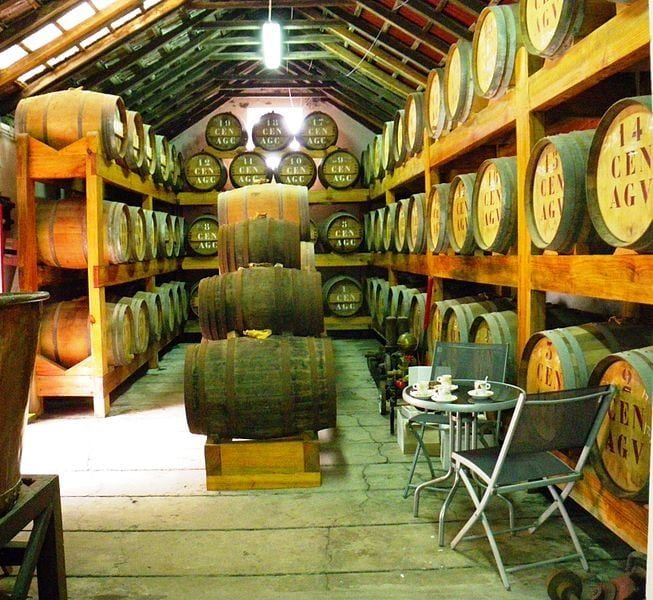
Rum barrels. Image: Wikimedia / MAClarke21

One bottling section of Bacardi's rum distillery. Image: Flickr / Joe Schlabotnik
THE DIFFERENT CATEGORIES/TYPES OF RUM
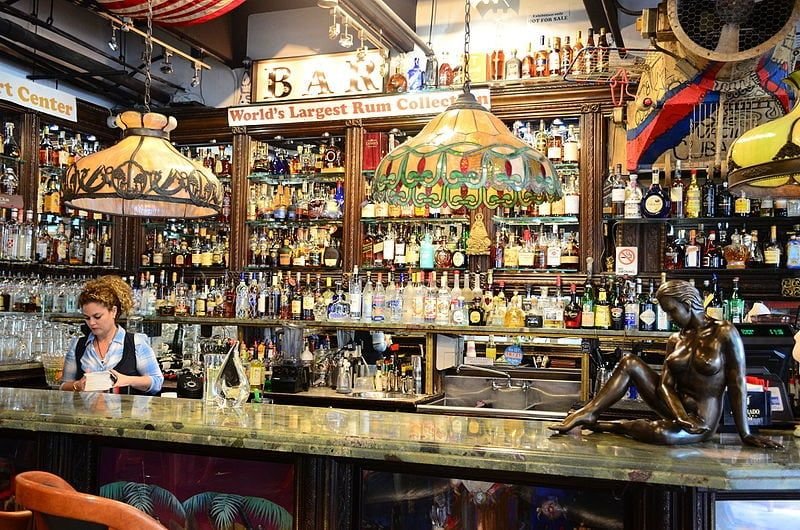
The world's largest rum collection. Image: Wikimedia / osseous
So, with all of those caveats in mind, here are some general rum categories that you'll most likely see pop up again and again — if you have all of these committed to memory, you'll undoubtedly be able to handle any questions that may come your way from bar patrons or (yeah, snarky) friends.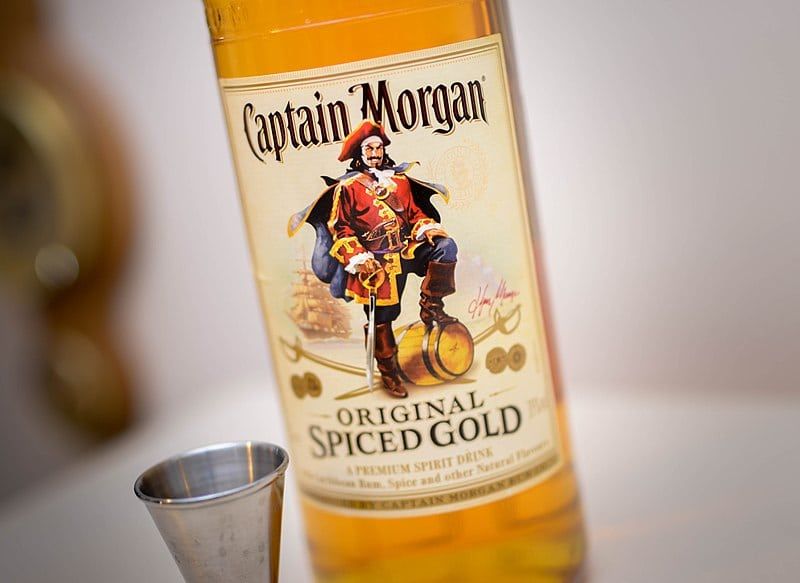
A bottle of Captain Morgan spiced rum. Image: Wikimedia / דג בלי מלח
Some of the best spiced rums include: Chairman's Reserve, Sailor Jerry, Sugar Island Spiced Rum, Bayou Spiced Rum, Cruzan Spiced Rum, and Malibu Spiced Rum. Gold (or amber or pale or...) rum: Gold rums are generally considered to be a midway rum between light rum and dark rum in terms of aging and coloration, and again gain their flavor profile mostly from the barrels in which they're aged. Like dark rums, gold rums can be used in tropical drink recipes, drunk by themselves on the rocks or neat, or used in food recipes that call for rum. Some of the best gold rums include: Havana Club Añejo 7 Años, Angostura 1919, Appleton Estate Rare Blend 12 YO, and Amrut Two Indies Rum. Light (or white or silver or...) rum: Light rums, despite their lack of color, are almost always aged for at least a few months to a year in either wooden or stainless steel casks. Those aged in wood casks have their color removed via charcoal filtering, hence their being totally clear. In terms of flavor profile, light rums generally don't have any of the flavors acquired by barrel aging or flavor infusion, and are most often used for mixed drinks. Light rums are also generally bottled at at least 40% ABV. So if you buy yourself a bottle of light rum, you'll definitely want to get some other drink ingredients to mix it with, 'cause it's by far the harshest to drink on its own.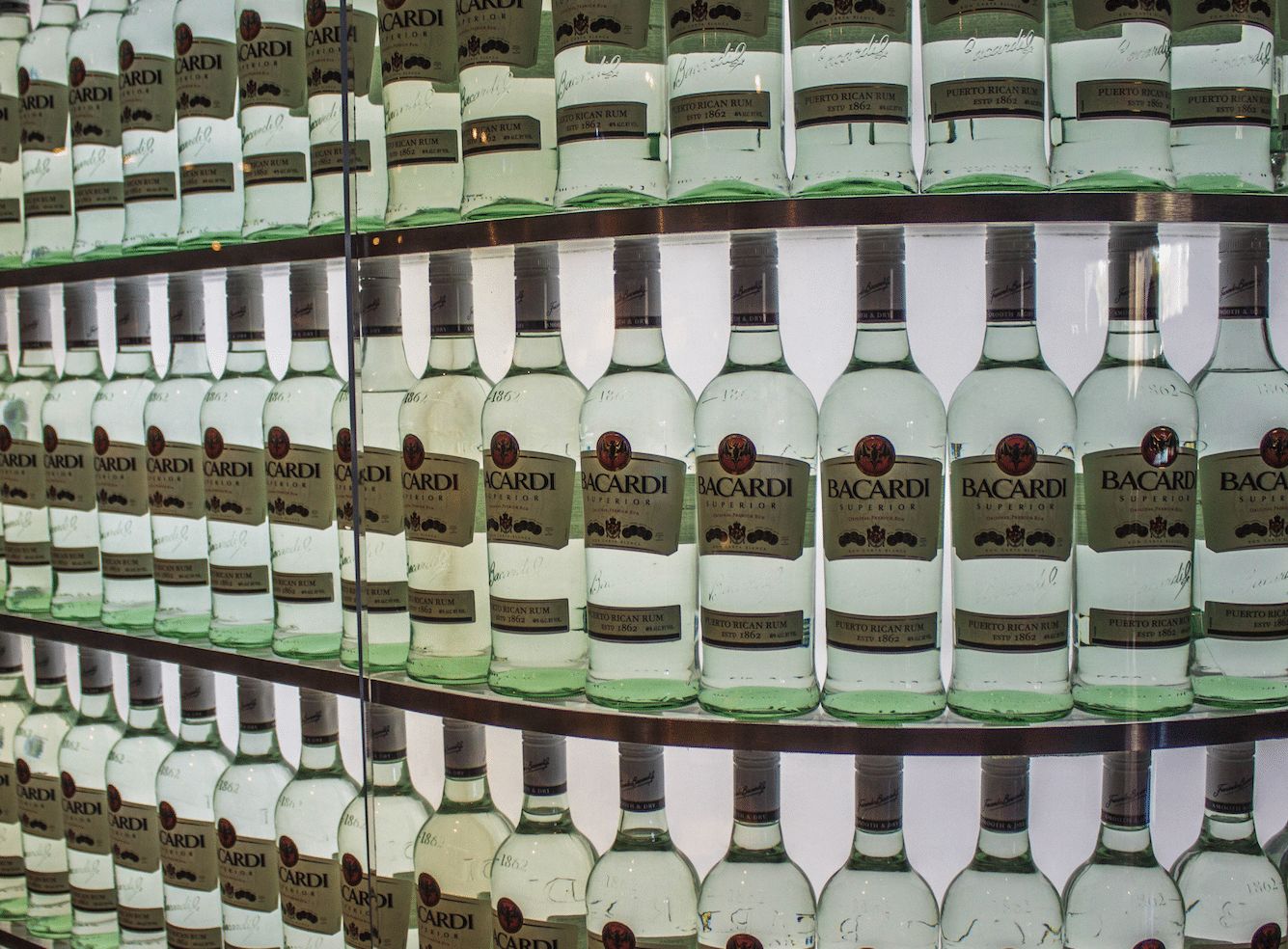
Some of Bacardi's white rum. Image: Flickr / Michael Au
Some of the best light rums include: Mount Gay Silver Rum, Banks 5 Island Rum, Brugal Especial Extra Dry, Caña Brava, and El Dorado 3 Year. Overproof rum: Overproof rums are rums that have a much higher proof (ABV) than normal rums. So while most rums you'll see on shelves will have an ABV of around 40% to 50%, overproof rums will have an ABV of 75% (150 proof) or even 80% (160 proof). These overproof rums achieve their extraordinary ABV level by not being diluted after being taken out of their casks. Some of the best overproof rums include: Lemon Hart 151, Hamilton 151, Wray and Nephew White Overproof Rum, and Damoiseau 110 Pure Cane Rum. Unfortunately, if you're in the U.S., the highest ABV overproof rum you'll be able to get your hands on is 75% due to the U.S. having laws against importing liquors with an ABV higher than that. But still, 75% is really dang strong — if you're looking for something with a higher ABV than that, we have to ask: What the heck are you getting yourself into? Although, to be fair, rums with a higher ABV than 75% are often consumed in the Caribbean, where, as Robs Rum Guide notes, "locals prefer a stronger drink." In fact, the most popular rum sold in Jamaica is Jamaica's Wray And Nephew White Overproof, which has an ABV of 63%. And oh, by the way, if you're looking to set a drink on fire, overproof rum is perfect. https://giphy.com/embed/7WMfMeHukYFJm Premium rum: If you're really looking to try the best of the best, you'll want to go with a premium rum. You know how a bunch of snobs will sip on — and critique — fancy whiskeys? Yeah, you can do the same thing with premium rums. Premium rums are those that have been aged for years and years in casks — maybe for a dozen years, or, in some very rare and expensive cases, 50 years — and are ideal when sipped on on their own neat or on the rocks. Seriously, pouring a premium 12-year-old rum into a mixed drink would be both a crime and a tragedy. In general, you can expect premium rums to have darker, richer colors, as well as heavy barrel-influenced flavors. These premium rums also tend to be the smoothest. Oh, and also by far the most expensive (Duh.) Some of the best premium rums include: Mount Gay Extra Old Rum, Ron Zacapa XO, El Dorado 12 Year Aged, Appleton Estate 21 Year Old Rum, and Navazos Palazzi Cask Strength. Black rum: Black rum is a category of rum you won't hear about a lot, but it's out there, so we'll cover it here. In general, black rums are the darkest, richest, most heavy bodied rums, and are also the rums that retain the most rich molasses and caramel flavoring produced by converting molasses into rum. Often times black rums are colored with burnt caramel to deliver that distinctive dark coloration. You may not be too familiar with black rum because it's often not drunk, but rather used in the baking and candy-making industries to help a given recipe achieve bold, sweet, and spicy flavors.
A bottle of Malibu Black rum. Image: Tipsy Bartender
Some of the best black rums include: Captain Morgan Black Spiced Rum, Kraken Black Spiced Rum, and Malibu Black Rum. Navy-strength rum: If you see a bottle of Navy-strength rum pop up in a bar or liquor store shelf, you basically need to know one thing: It's roughly 57% ABV. Seriously, that's about the only defining characteristic of navy-strength rum. Aside from that, Navy-strength rum is all about its association with the British Royal Navy. As outlined in the history of rum section, the British Royal Navy was supplied with rum, and navy-strength rum aims to duplicate that type of rum as closely as possible — although it's not cut with water and/or lime juice. As for why it's roughly 57%, that's because when 18th century sailors used to test the strength of the rum they were given, they would combine it with gunpowder, and light the resulting paste on fire to see if it would explode. If it did explode, then the rum had an acceptable amount of alcohol. If the gunpowder didn't explode, then the sailors would turn their noses up in distaste. Later, in the 19th century, thanks to more advanced alcohol-measurement tools, it was discovered that the ABV required to make this gunpowder explosion happen is 57%. Hence navy-strength rum having an ABV of around 57%.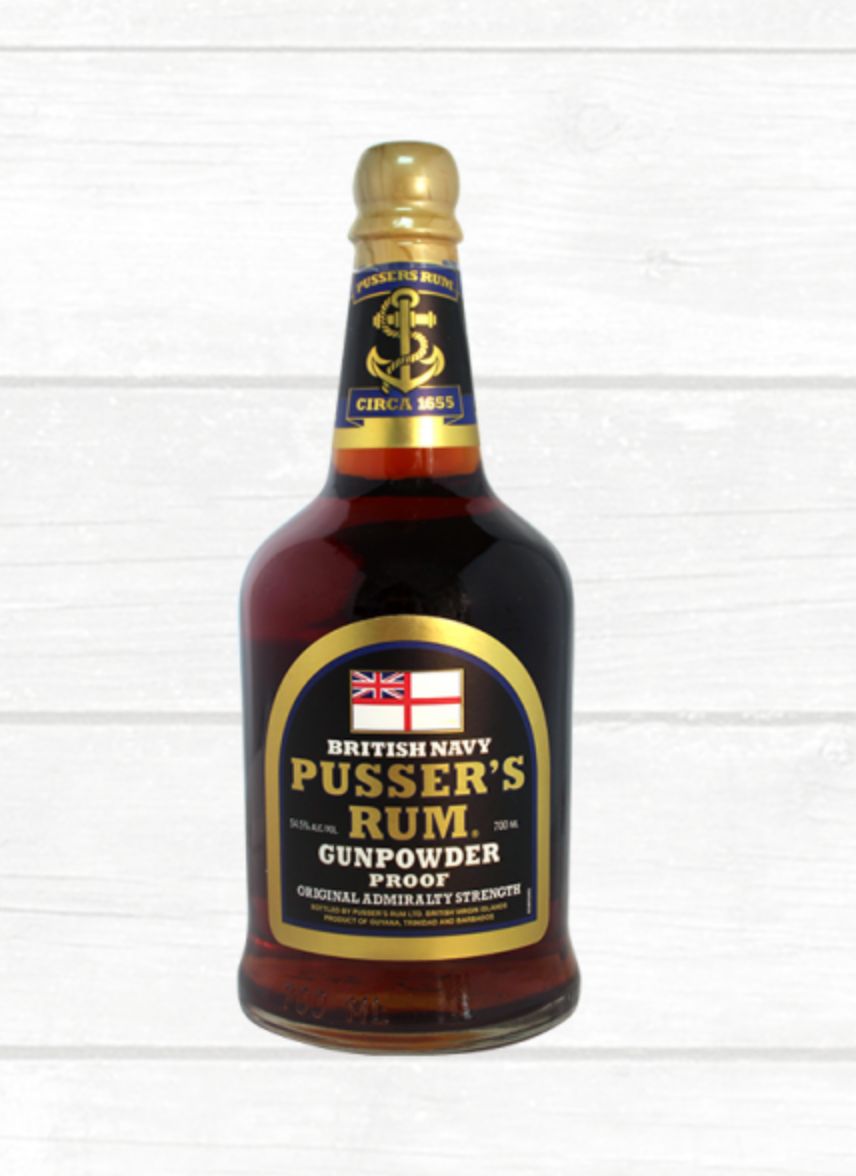
Pusser's "Gundpowder Proof" rum. Image: Pusser's Rum LTD
Some of the best navy-strength rums include: Pusser's Rum Black Label: Gunpowder Proof, Lost Spirits Navy Style Cask Strength Rum, and Rumbullion! Navy Strength. Aguardiente: Aguardiente a type of rum that isn't aged and is often infused with anise flavoring — anise is a plant that has a very sweet taste and aromatic properties, and tastes some what similar to black licorice. The name Aguardiente translates to "burning water" or "fire water." Some of the best aguardiente rums include: Aguardiente Néctar Premium, Aguardiente Real 1493, and Puro Colombia Aguardiente Sugarless. Rhum Agricole: When it comes to Rhum Agricole, what you'll need to know is that it's mainly made in the French territories of the Caribbean, and that it's fermented and distilled from pure, fresh sugarcane juice — no molasses base for this type of rum. In regards to its flavor profile, Rhum Agricole generally retains more of the original sugarcane juice flavors, and is distilled to anywhere from 40-55% ABV. In terms of aging, Rhum Agricole is often only aged for three to six months inside a wooden cask, although, as Wikipedia notes, "Rhum Vieux," or "old rum," is aged for three years. Side note: Rhum Agricole coming from Martinique — a French territory in the Caribbean — is labeled with an Appellation d’Origine Contrôlée or AOC, which basically signifies that a given Rhum Agricole is indeed authentic and was made in Martinique.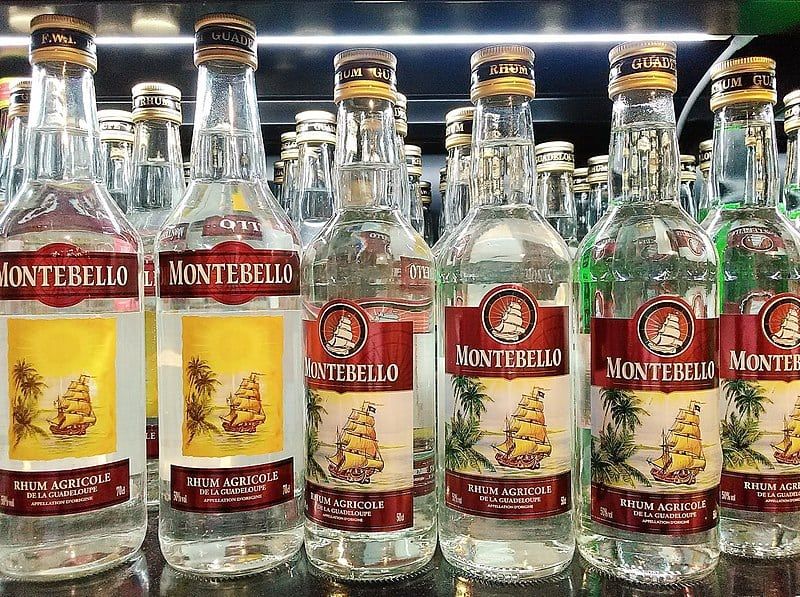
Montebello brand of Rhum Agricole — note the clarity of the rum. Image: Filo gèn'
Some of the best Rhum Agricole rums include: Clément Cuvée Homere, La Favorite Rhum Agricole Vieux, Saint James Extra Old, Trois Rivières Ans D'Age 12 Rhum Vieux Agricole, and Darboussier Rhum Vieux Agricole. Cachaça: Cachaça (pronounced kah-SHA-sah) is a type of rum that is produced exclusively in Brazil. Like Rhum Agricole, Cachaça is made from fresh sugarcane juice, although it is most often bottled with either only a little aging, or no aging at all. Cachaça is generally best used in mixed drinks, although there are artisanal Cachaças, which can be sipped on neat or on the rocks. Some of the best Cachaça rums include: Novo Fogo Cachaça, Avuá Cachaça, Yaguara Cachaça, Leblon Cachaça, and Sagatiba Cachaça. Seco (or Seco Herrerano): Seco is just like Cachaça except it's made exclusively in Panama. Seco is triple distilled and made from solely from sugarcane juice rather than molasses. Some of the best seco rums include: Abuelo Añejo 7 años, Cana Brava Rum, Panama Pacific Rum 23 Year, Selvarey Rum Cacao, Grander Panama Rum 8 Year, Zafra 21 Year Rum.
A bottle of Cruzan Single Barrel rum. Image: Flickr / Steve Bennett
Black strap rum: Blackstrap rum is basically a very dark rum, except it's made with "black strap" molasses — the darkest molasses byproduct from the sugarcane juice extraction process. The flavor profile of black strap rum is generally sweet and smokey; sweet from the rich molasses and smokey from the fact that black strap rums are barrel aged in charred barrels. Some of the best black strap rums include: Cruzan Black Strap, Blackwell Black Strap Rum, Coruba Black Strap Rum, and Appleton 12 Black Strap Rum.HOW TO DRINK (AND EAT) RUM
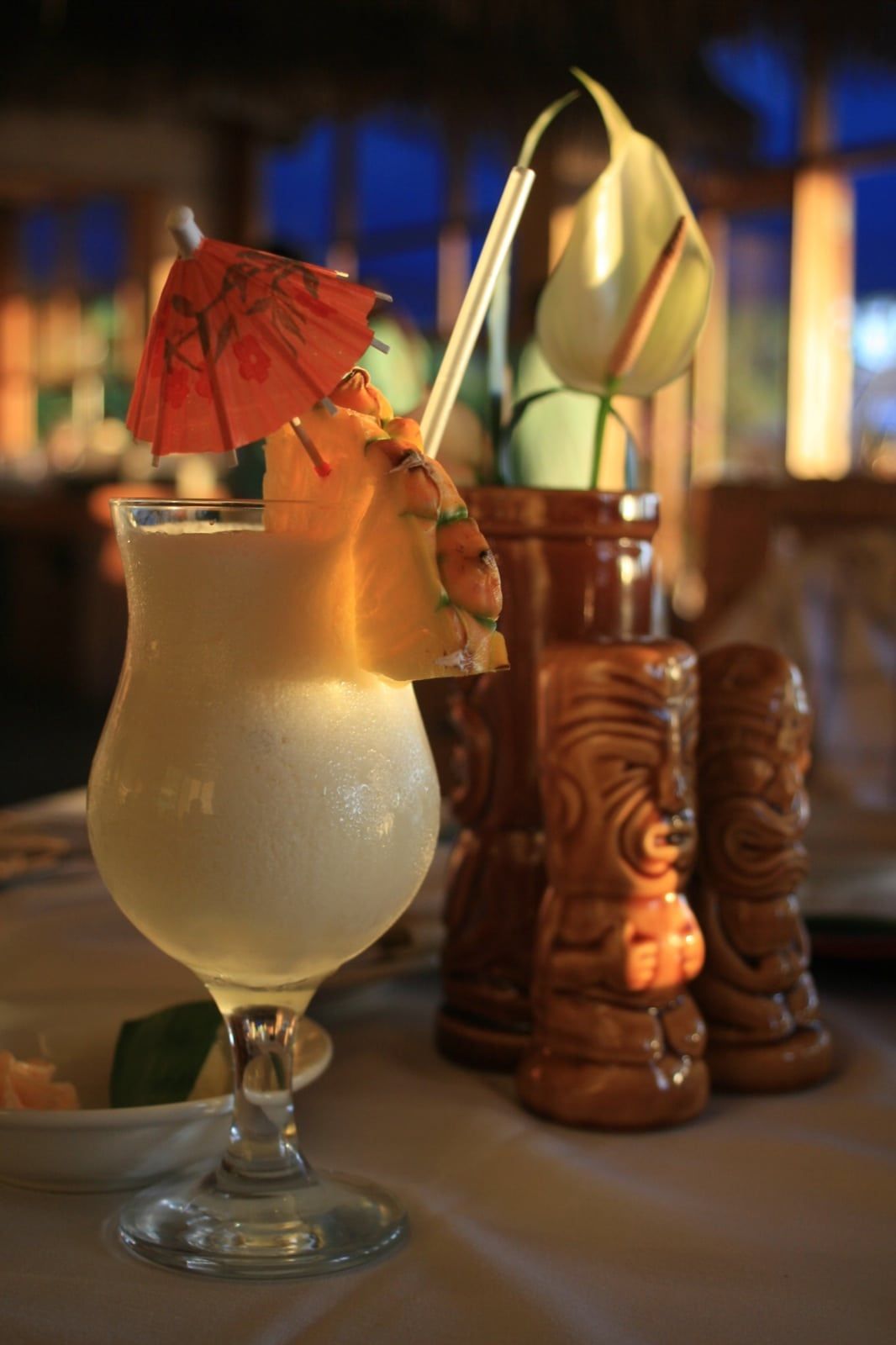
Beautiful little piña colada — a classic rum cocktail. Image: Flickr / Randy Robertson
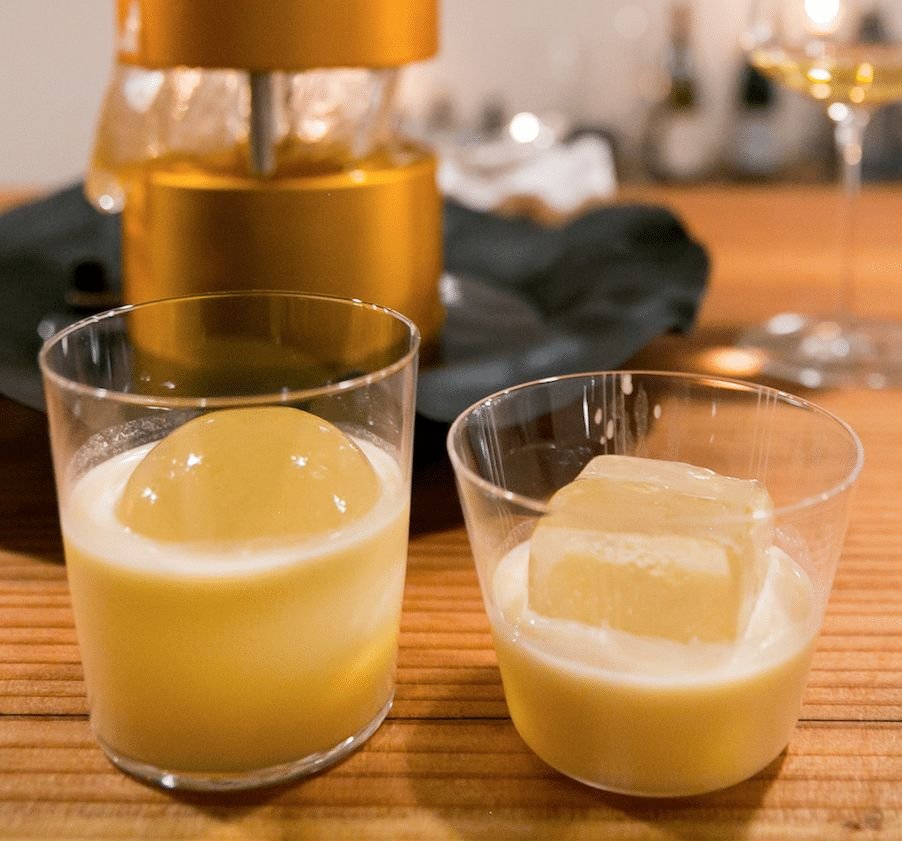
This is what your rum on the rocks should look like. Image: Flickr / City Foodsters
Once you've selected your rum of choice, you can more or less follow the same guidelines as those laid out for drinking whiskey on its own. This means that you'll want to pour it in a glass at room temperature — grappa glasses work great due to their ability to funnel and capture aromas — and then let your nose lead the way. Make sure you're sniffing with caution, however, as rum can overwhelm your sense of smell with its strong ethanol vapors (you're not sipping on a low ABV wine here, OK?). Once you've taken a few gentle sniffs (really though, take your time and sniff slow), it's time to get some rum on your tongue. Again, with tasting rum, basically treat it as a whiskey. So just sip a bit, chew on it a bit, and then swallow. While you'll most likely get the harshest alcohol taste during the actual sip, you'll be treated to a bouquet of flavors with your first post-drink exhale. With a good rum you can expect to pick up on a ton of flavors — including vanilla, oak, caramel, cloves, and toasted nuts — with many of them coming from the barrel in which the rum was aged.
A grappa glass. Image: Flickr / Ansgar Koreng
Oh, and regarding ice and water: With higher ABV rums, say anything over 40%, you'll probably want to do some dilution with a splash of water or a fat ice cube. Don't freak out hearing this by the way. No pro is going to look down on you for trying to get the maximum flavor experience out of your very expensive bottle of rum.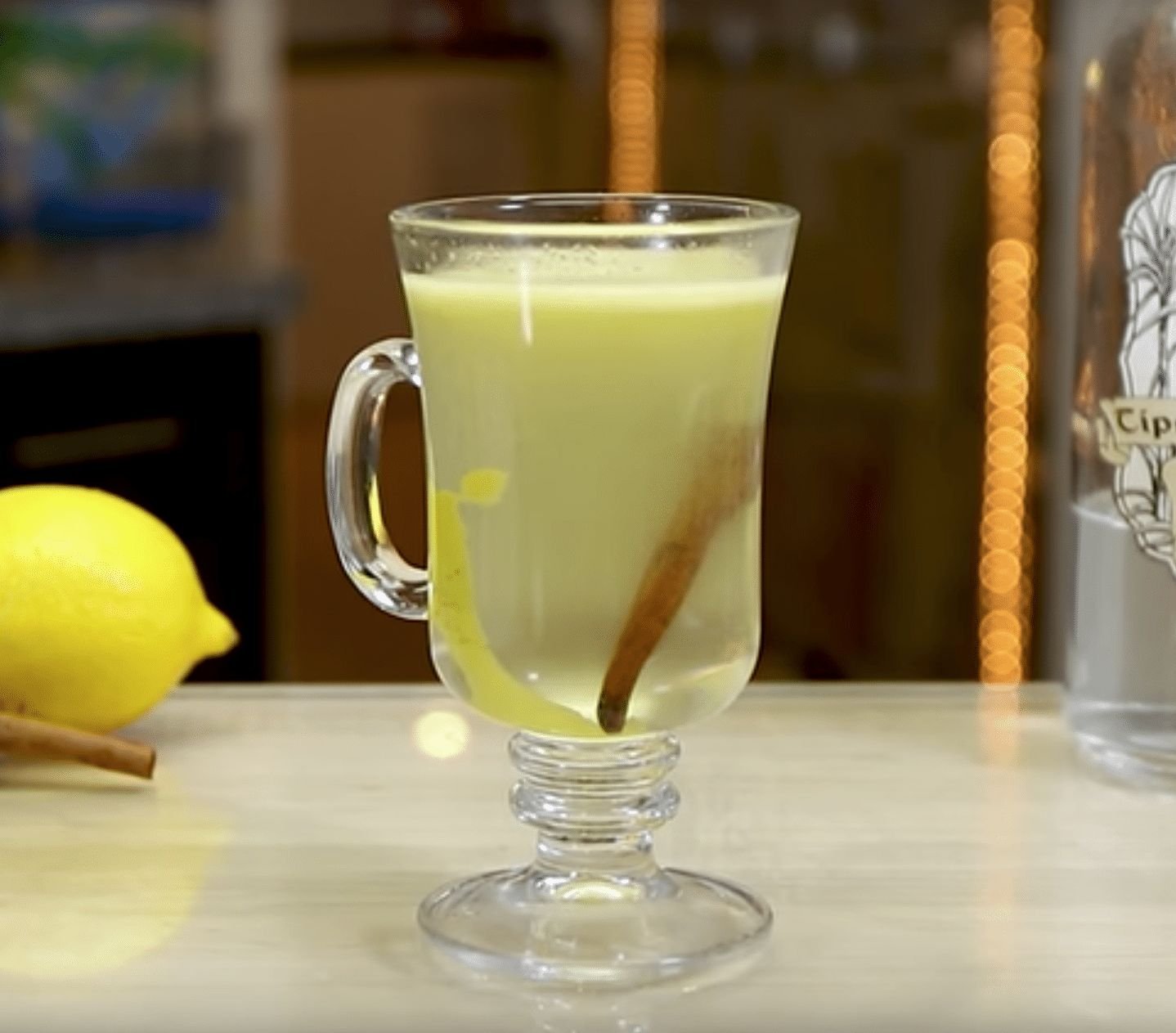
Hot Toddy. Image: Tipsy Bartender
There isn't much further elaboration that's needed here. Basically all you need to do is make any of these drinks following the non-alcoholic recipe, and then add as much rum to it as you'd like. Although we do have a few hot rum drink recipes with exact measurements for you to check out below with recipes six through ten.SOME OF THE MOST POPULAR RUM DRINK RECIPES
1. MAI TAI 1 1/2 oz. (45ml) White Rum 3/4 oz. (22ml) Dark Rum 1/2 oz. (15ml) Orange Curacao 1/2 oz. (15ml) Lime Juice 1/2 oz. (15ml) Orgeat Syrup Pineapple Wedge Mint Cherry PREPARATION 1. Shake all ingredients besides the dark rum together over ice. 2. Add ice to serving glass and strain mix over. Float dark rum on top. 3. Garnish with pineapple wedge, mint sprig and cherry. 2. DAIQUIRI CLASSIC DAIQUIRI 2 oz. (60ml) Light Rum 1 oz. (30ml) Fresh Lime Juice 1/2 oz. (15ml) Simple Syrup Garnish: Lime Wheel PREPARATION 1. Fill coupe glass with ice and set aside to chill. 2. In an ice filled shaking glass combine rum, lime juice and simple syrup. Shake well. 3. Discard ice from serving glass and strain mix inside. Garnish with a lime wheel. 3. PIÑA COLADAHOW TO STORE RUM
When it comes to storing your rum, you can relax and forget about all your troubles, 'cause you really don't need to do anything special. As with most other hard liquors, all you need to do to store rum properly is keep it in a moderately cool, dry place, out of direct sunlight. If you have a pantry, that would be ideal. If your bottle of rum is opened, don't stress, just make sure to reseal it with a cap and then pop it in your cool, dry containment area (containment area doesn't sound right, but let's roll with it). As long as your bottle is properly sealed and stored correctly, it should last (more or less) indefinitely. Although even stored in a cool, dark place, some of the rum is going to evaporate out of the bottle. Then, once you're ready to serve your rum, you may want to pop it in the refrigerator first, because most people would prefer their rum chilled rather than served at room temperature, especially if it's going in a fruity tropical cocktail.THE FUTURE OF RUM
Alright people, now you know just about everything you need to about rum! So what does the future hold for this delicious, (usually) Caribbean spirit? A lot of growth! Seriously, the worldwide rum business is growing faster than wild sugarcane grass in a perfect tropical climate. According to The Morning Advertiser, "rum will overtake gin as the next big spirit." The Spirits Business describes a "rum renaissance" in which there's "certainly upward momentum [for the rum market]." And (as mentioned earlier) The Drinks Business noted in 2017 "rum is poised to break [the] £1 billion sales barrier [in the UK]." So yeah, if you're looking to make a big chunk of change, it may be time to invest in rum. https://giphy.com/embed/JsD2xLFHuZxQxyMxX0 But it's not all types of rum that are getting that kind of growth love — it's mainly the premium and super-premium rums. As Mauricio Vergara, CMO of Bacardi North America, noted in the aforementioned Spirits Business article, “The biggest trend in rum is that it’s premiumising. Increasingly we are seeing growth in premium and super-premium rums, and I think it’s a trend that is going to keep accelerating.” This sentiment is echoed pretty much anywhere you look, with Market Watch, for example, noting that "The rum industry is headed toward the premium tiers, defined as being above $20 per 750-ml," and that "Amid all the upscaling in Bourbon and Scotch, rum makers are determined to get their share of space at the high end, and are rolling out aged rum offerings to draw in those same consumers."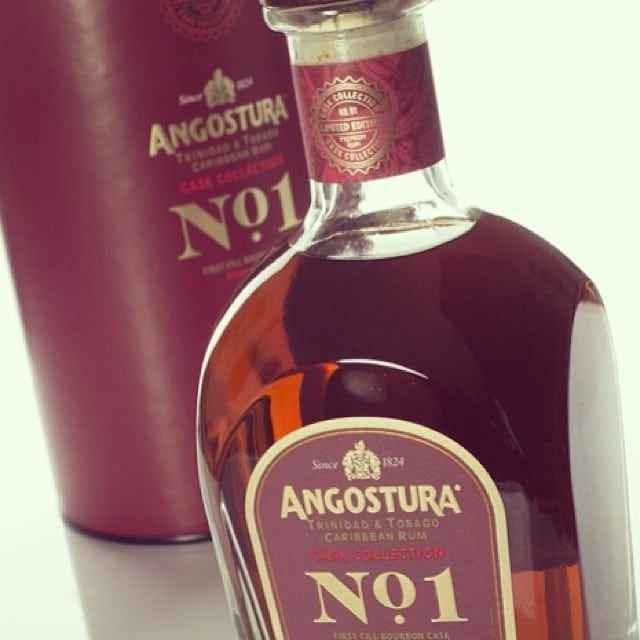
Angostura premium rum. Image: Flickr / IZATRINI.com
FIVE OF OUR FAVORITE RUM DRINKS
OK, enough learning, it's time to get to drinking! With that in mind, here are five our favorite rum cocktails. 1. CARIBBEAN SUNSET RUM PUNCH https://www.youtube.com/embed/o5Qs8xjXeJE 2. THE BAHAMA MAMA https://www.youtube.com/embed/CFhh8sOGE8s 3. THE DIRTY BANANA https://www.youtube.com/embed/Jb_BUr-vzxs 4. THE PAINKILLER https://www.youtube.com/embed/YsLOxNHSH84 5. JAMAICAN RUM PUNCH https://www.youtube.com/embed/Y9O374TiR_k GIFs: Giphy
Independence Day Drinks
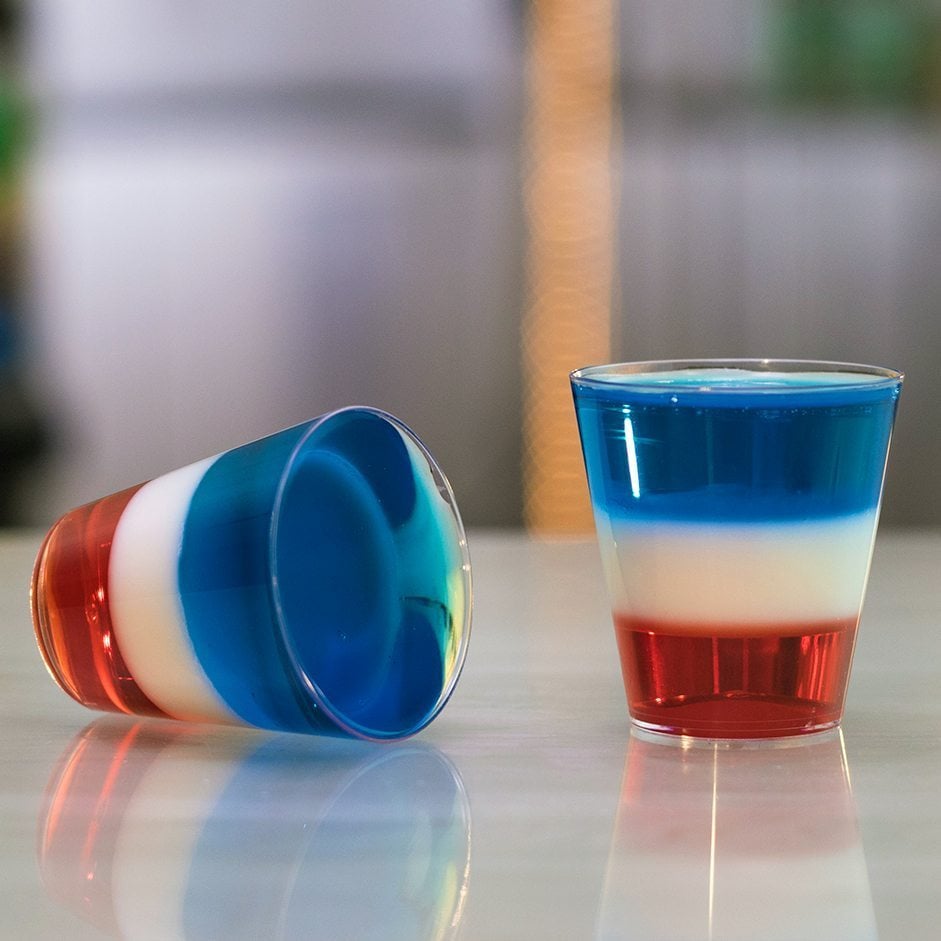
4th Of July All American Jello Shots

4th Of July Cake Vodka Milkshake

4th Of July Diversity Bomb Shot
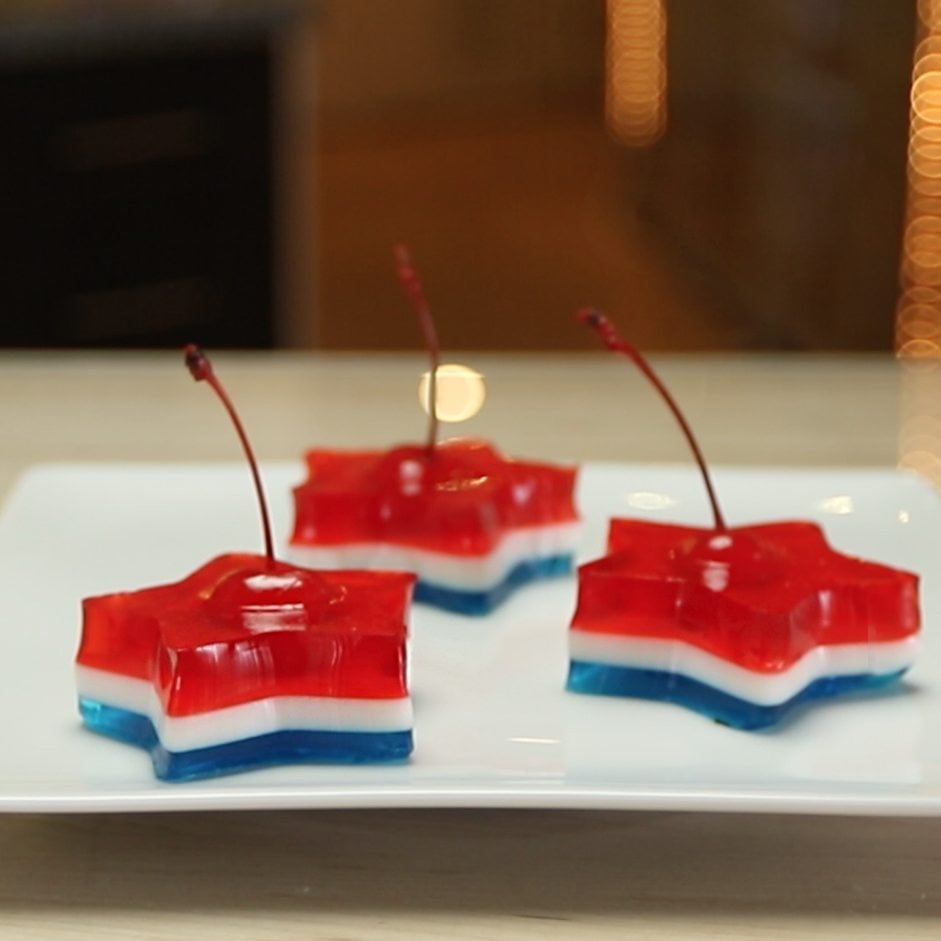
4th Of July Jello Shots
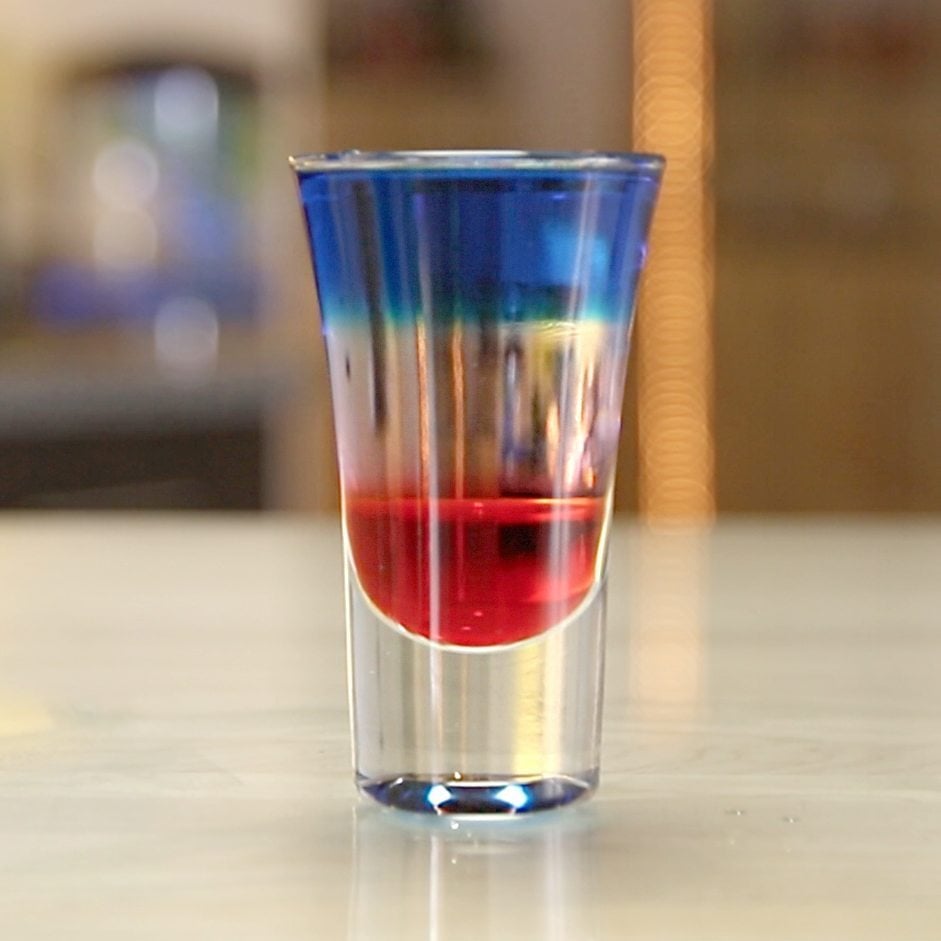
4th Of July Layered Shots
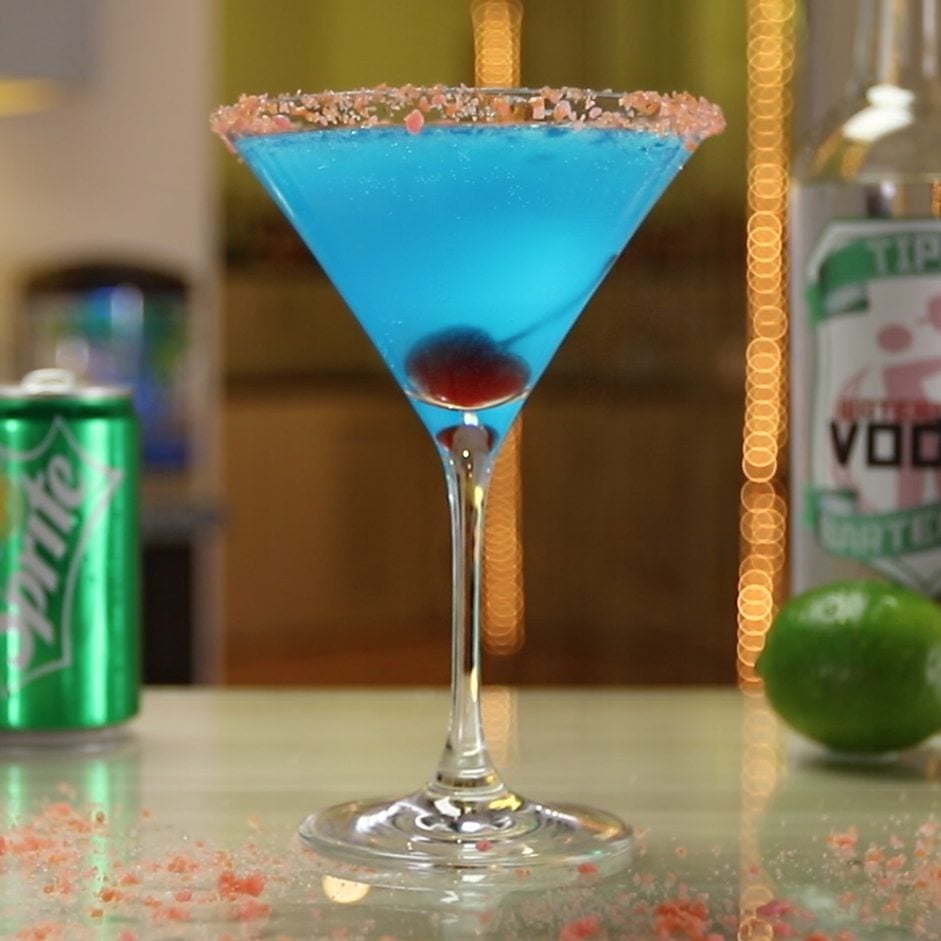
4th Of July Pop Rocks Martini
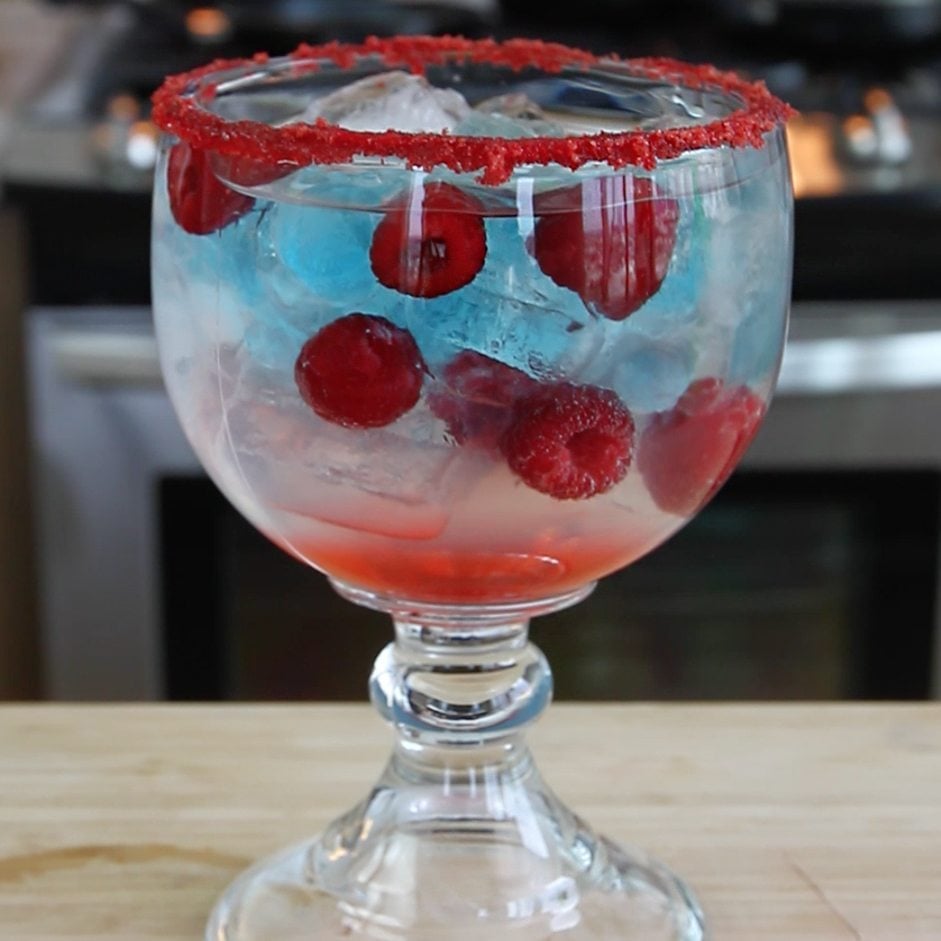
4th Of July Raspberry America

4th Of July Spiked Bomb Pops

4th July Popsicle Margarita
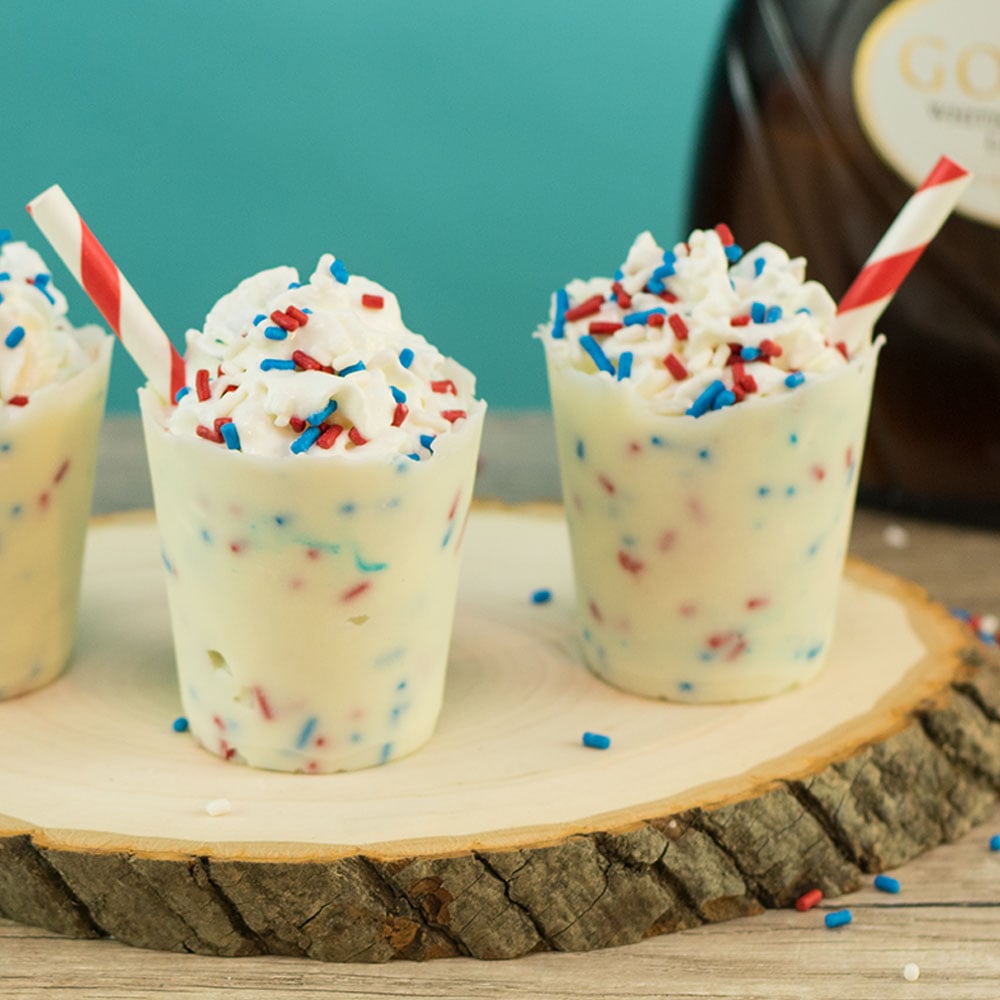
4th July Edible Shot Glasses
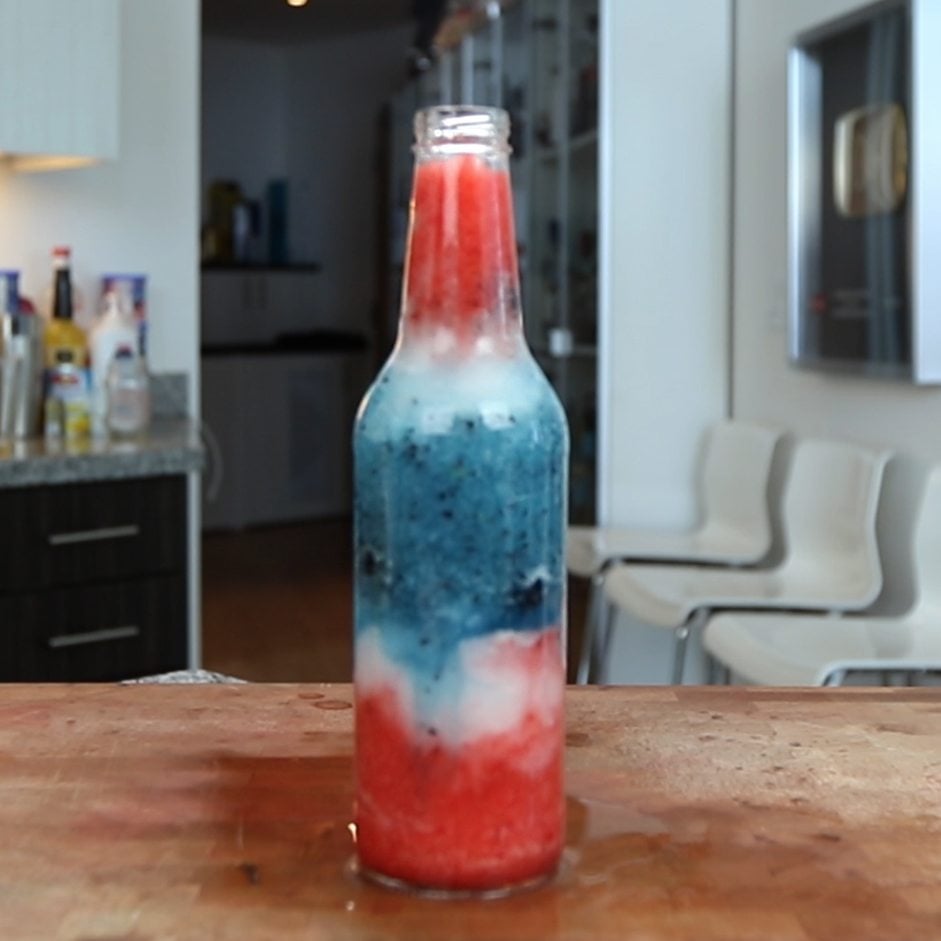
4th July In A Bottle
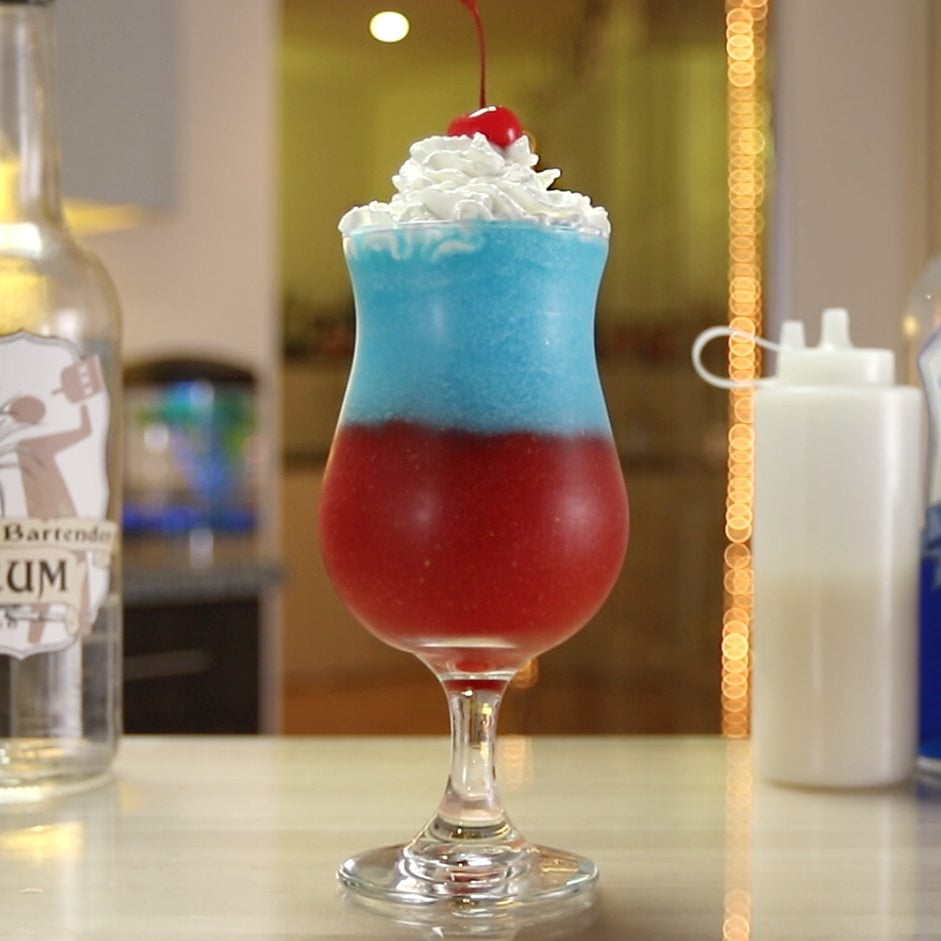
All American Daiquiri


